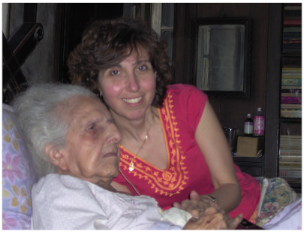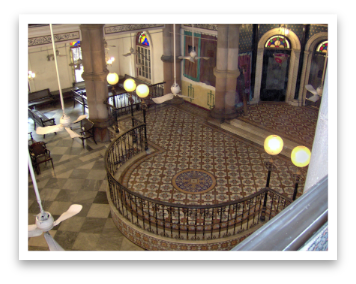Return to India, 2006: Clinging to a Long Branch
By Rahel Musleah
A literal journey down memory lane recalls a proud Jewish heritage for two sisters traveling to their former family home.
The sign above the door at 11 Bowbazaar Street in Calcutta still says I.S. Musleah, my grandfather’s name. The white letters I recall from my first return here with my parents in 1997 have faded into the blackened wood, dimming my family’s vibrant presence in what many think to be one of the most unlikely places on earth for a Jew. This city where I was born and which I left as a child of 6 has haunted me, beckoning me to sift through my insubstantial memories and restore it to flesh and blood. No. 11, as it was known, is often the centerpiece of those memories: My father’s extended family, part of a Baghdadi clan that moved to Calcutta in 1820, lived in the apartment for 80 years, and the stories of their lives have become intertwined with my own.
This time, I am making the trip with my older sister, Flora, who has not been back until now. Without our parents here, I am the “expert” with the directions and stories that I have collected.

“Enjoy every moment of your trip,” my mother added. I sobbed, wishing they were going with me.
Flora and I spend the night before our visit to Bowbazaar at the four-star Kenilworth Hotel on Shakespeare Sarani. If it were not for the wafting strains of local music outside, we could be anywhere. Our room is decorated in contemporary teal and white, with a television, Internet access, showers with hot water and air-conditioning. Nearby, an upscale shopping mall houses a Sephora beauty supply store. It does not feel right to be pampered—last time, I stayed in the primitive conditions at No. 11.
In the morning, we meet our guide, Amitava Mukhopadhyay. A former journalist, he has a passion for this city of 18 million, now called Kolkata to reflect the Bengali pronunciation. He explains its history with maps, pictures and charts. When we mention that we are not the standard tourists, Amitava determines to do everything in his power to fulfill our mission, which he dubs “the two Calcutta girls’ homecoming.”
In grueling heat, we set out for Bowbazaar before breakfast, and soon, we are gazing at the sign with my grandfather’s name. Faded or not, I can hardly believe it is still here. The journey up the dark stairs takes no more than a few seconds, but it is as if we have time-traveled to another era when we arrive at the front door and kiss the mezuza. Rekha, the ayah who takes care of Auntie Ramah, welcomes us inside.
Auntie Ramah is in a white shift, her white hair a halo around her fragile face. She looks at us blankly. She is hard of hearing and can barely make out what we are saying. Flora, who especially loved her as a child, tries to talk to her: “I’m Ezekiel’s daughter, Flora. Do you remember? You taught me embroidery.”
I remember when i was little, i would come and study here. I would practice piano here. Rekha brings her robust, yellow-saried body close to Auntie Ramah and speaks to her loudly in Hindustani. “Tumra batscha eedar hai,” she says. “Auntie, tum bolta? Tum piar karo.” Your children are here. What do you say? Love your children.
I try to get Auntie Ramah to tell us something about my grandfather, her older brother Isaac, who helped sustain his unmarried sisters on his wages. He died in 1955, before I was born. Her answers are abridged and simple: “He was very strict. He made us wear stockings when we went out.”
“Can you sing some of the prayers?” I ask.
Rekha brings a siddur and magnifying glass. “Saturday morning, the nimaz [prayers], the ha-Motzi,” Rekha prompts. Auntie Ramah opens to Mizmor Le-David, the psalm that always precedes ha-Motzi on Shabbat in our tradition. “Al mei menuhot yenahaleini,” she chants in a singsong. By the waters of tranquillity, God will lead me. None of us can contain our tears.
“Darling, don’t cry,” Rekha admonishes Auntie Ramah. “You cry, your children also cry.”
Flora and I need relief. I ask Rekha to unlock the small storage pantry that figures prominently in stories of my father’s childhood: He and his cousin used to dip stealthily into glass jars of cheese sambusaks and date babas (pastries) stored there. Now, there are only dusty earthenware containers and decanters wrapped tightly with newspaper and twine. My great-grandfather’s siddurim and books still line another cabinet, still neat in their red, brown and blue bindings.
Off the crude bathroom, Rekha opens another padlocked room. We unearth a mystery object covered with a dishcloth: a big glass jar with an ancient bone.
This is the zero’a, the dried shankbone Auntie Ramah keeps from year to year for Passover. I recognize a large, deep wicker basket as the kuncha, the tray that hung from the ceiling to keep the matza out of hametz’s way before Pesah.
We promise to return the next day and go back down to meet Amitava. We then head to Bow Street, where, in 1946, my father was in the middle of getting his hair cut when, on the cusp of Indian independence, the Hindu-Muslim riots broke out. He left the shop with half a haircut.
The yellow façade of the beth El Synagogue rises majestically above Pollock Street, a few blocks away from Bow Street, and down Canning Street, the Maghen David synagogue’s red-brick steeple pierces the sky. In India, synagogues grow organically from the markets and bazaars. No long, circular parking lots demarcate synagogue property. Maghen David is in the bangle- bracelet market, with its colorful bunches of plastic and glass flashing enticingly. India encroaches right up to the synagogue gates.
A new sign in the courtyard declares the synagogue a government heritage site. To me, that means the synagogue where my father became a bar mitzva, where he served as rabbi for 12 years and where my family spent every Shabbat is officially a monument instead of a living institution. The myrtle bushes are blooming, and I wonder how a simple bush still sends out its fragrance when the people who were rooted to this spot of earth have all died or left.
Flora and I enter the sanctuary with anticipation and trepidation. Ibu, an elderly Muslim Indian who has been serving the synagogue as caretaker for generations, turns on the lights one by one. The soaring architecture comes alive: the vibrant stained-glass windows, the painted menora and stars in a blue dome above the heikhal (Ark room), the plain wooden benches surrounding the teba (bima), the various religious books and siddurim in their wooden boxes and the women’s section in the balcony.
I am stricken by the beauty of the place. Everything is in good repair, but there is no community to use it.
Last time I was here, my father stood on the teba, and I had said, “Daddy, sing something.” And he did.
Last time I was here, there was a minyan on Shabbat, and I asked for an aliya. Since this is an Orthodox synagogue, of course I didn’t get one. So this time, it is up to me. I face the heikhal and sing what enters my heart—one of the opening psalms for Shabbat, in the Calcutta melody: “Ha-shamayim mesaprim kevod....” The heavens tell of God’s glory. And then Nishmat, from the morning service: The breath of all living things praises God. Flora sings with me.
I can feel my voice breathe life into the hollows. It is humbling and exalting at the same time. I struggle with why this continuity is so important to me. I love this heritage fiercely and I try to pass down what I can to my two daughters—and, honestly, almost everyone I meet. But it’s difficult in an American Ashkenazic milieu. I realize that, while I will continue my mission, what I am facing is a kind of letting go.
When he hears we are Rabbi Musleah’s children, Ibu opens the heikhal without the letter of permission visitors usually need. Inside there are two Torahs in beautiful, polished silver tiks given by the founding Ezra family. Two Torahs in any other synagogue would be sufficient, but here it’s a paucity. At one time, the heikhal was filled with 75, each one dedicated by a synagogue member in memory of a relative. Before we leave, I open one of the Torahs and read the portion of the akeida, the binding of Isaac, in the Calcutta trope.
At night, we go to Kalighat, a shrine to the goddess Kali, then to the Taj-like Victoria Memorial, where we enjoy a sound-and-light show and a stroll along the river. The traffic is unnerving: Cars whiz by so close we can almost touch them; rickshaw cabs run alongside, and once in a while a stray cow wanders by. Back at the hotel, I do not feel so guilty to be pampered.
At the Calcutta Jewish cemetery the next day, climbing over weeds and brambles, we locate the family graves from among the 3,000 stones. I direct the caretakers to hack away the weeds, and they do so with small machetes. Flora cries at our Grandmother Flora’s grave.
We stop at Nahoum’s Bakery, owned by 80-year-old David Nahoum, who handles most of the Jewish community’s affairs, and return to Bowbazaar for lunch and another visit with Auntie Ramah. Later, we arrange to visit the Jewish Girls School at the building on Park Street where we were students.
Flora recalls that, as a 7-year-old, she played the Zionist Palmah March on the piano as the children came into the auditorium every morning. The piano still graces the corner of the room; plaques list the school’s students, including my grandmother, mother and aunts. The school’s managing committee is still Jewish, but its 800 students are not. As I watch the girls in maroon skirts, white shirts, white socks and black Mary Janes line up in the courtyard, their black braids looped up and tied with ribbons as ours used to be, I think that this must have been how we looked as little Indian girls.
I carry all these new and reawakened memories back with me to New York. Two months after our trip to India, Auntie Ramah died. Our last physical link with Calcutta—severed.
I asked a family friend visiting Calcutta to retrieve the sign with my grandfather’s name. It now hangs on a wall in my home above my grandparents’ portraits.
Printed in Hadassah Magazine, Dec. 2007
